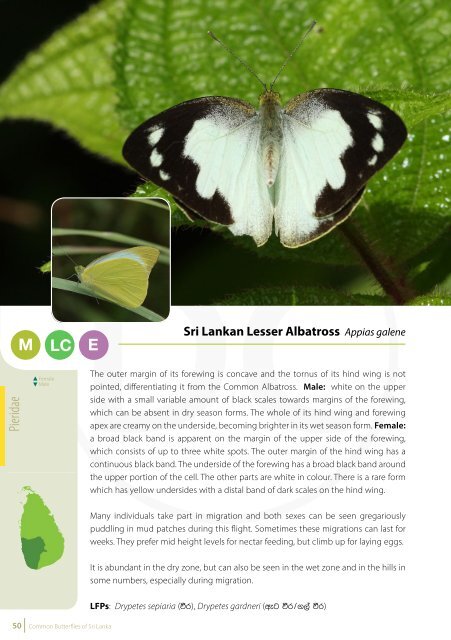Common Butterflies of Sri Lanka
Common Butterflies of Sri Lanka
Common Butterflies of Sri Lanka
Create successful ePaper yourself
Turn your PDF publications into a flip-book with our unique Google optimized e-Paper software.
M<br />
<strong>Sri</strong> <strong>Lanka</strong>n Lesser Albatross Appias galene<br />
White Orange Tip Ixias marianne<br />
LC E S<br />
LC<br />
Pieridae<br />
Female<br />
Male<br />
The outer margin <strong>of</strong> its forewing is concave and the tornus <strong>of</strong> its hind wing is not<br />
pointed, differentiating it from the <strong>Common</strong> Albatross. Male: white on the upper<br />
side with a small variable amount <strong>of</strong> black scales towards margins <strong>of</strong> the forewing,<br />
which can be absent in dry season forms. The whole <strong>of</strong> its hind wing and forewing<br />
apex are creamy on the underside, becoming brighter in its wet season form. Female:<br />
a broad black band is apparent on the margin <strong>of</strong> the upper side <strong>of</strong> the forewing,<br />
which consists <strong>of</strong> up to three white spots. The outer margin <strong>of</strong> the hind wing has a<br />
continuous black band. The underside <strong>of</strong> the forewing has a broad black band around<br />
the upper portion <strong>of</strong> the cell. The other parts are white in colour. There is a rare form<br />
which has yellow undersides with a distal band <strong>of</strong> dark scales on the hind wing.<br />
Many individuals take part in migration and both sexes can be seen gregariously<br />
puddling in mud patches during this flight. Sometimes these migrations can last for<br />
weeks. They prefer mid height levels for nectar feeding, but climb up for laying eggs.<br />
It is abundant in the dry zone, but can also be seen in the wet zone and in the hills in<br />
some numbers, especially during migration.<br />
Its upper side is white with a large orange patch on the apex <strong>of</strong> the forewing. This<br />
patch is interrupted by small black markings in females. The outer margins <strong>of</strong> both<br />
wings are edged in black. Its yellow coloured under side is faintly mottled in dark<br />
scales, and has a light orange area on the forewing. Sometimes, the white patches on<br />
the distal band are reduced greatly, leaving only the dark outlines. Variations in colour<br />
and pattern among individuals are common.<br />
The White Orange Tip becomes active soon after the morning sun shines, and keeps<br />
flying even at mid day. It occasionally spreads out its wings for basking, in the early<br />
morning hours. It is fond <strong>of</strong> flying in sparse scrublands scattered with herbaceous<br />
plants. It is especially attracted to Leucas zeylanica (.eg ;=U) flowers. The females lay<br />
eggs on the dead branches <strong>of</strong> their larval food plants.<br />
It is restricted to the dry lowlands and is common in scrubland areas, being much<br />
more abundant in northern parts <strong>of</strong> the island.<br />
LFPs: Capparis grandis, Capparis sepiaria<br />
Male<br />
Pieridae<br />
LFPs: Drypetes sepiaria (ùr), Drypetes gardneri (weg ùr$.,a ùr)<br />
50 <strong>Common</strong> <strong>Butterflies</strong> <strong>of</strong> <strong>Sri</strong> <strong>Lanka</strong><br />
<strong>Common</strong> <strong>Butterflies</strong> <strong>of</strong> <strong>Sri</strong> <strong>Lanka</strong> 51















